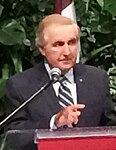Saskatchewan general election, 1991
|
|
|||||||||||||||||||||||||||||||||||||||||||||||||||||
|---|---|---|---|---|---|---|---|---|---|---|---|---|---|---|---|---|---|---|---|---|---|---|---|---|---|---|---|---|---|---|---|---|---|---|---|---|---|---|---|---|---|---|---|---|---|---|---|---|---|---|---|---|---|
|
|||||||||||||||||||||||||||||||||||||||||||||||||||||
|
|
|||||||||||||||||||||||||||||||||||||||||||||||||||||
|
66 seats in the Legislative Assembly of Saskatchewan 34 seats needed for a majority |
|||||||||||||||||||||||||||||||||||||||||||||||||||||
|
|||||||||||||||||||||||||||||||||||||||||||||||||||||

|
|||||||||||||||||||||||||||||||||||||||||||||||||||||
|
|||||||||||||||||||||||||||||||||||||||||||||||||||||
Grant Devine
Progressive Conservative
The Saskatchewan general election of 1991 was the twenty-second provincial election held in the Canadian province of Saskatchewan. It was held on October 21, 1991, to elect members of the Legislative Assembly of Saskatchewan.
The Progressive Conservative government of Premier Grant Devine was defeated by the New Democratic Party, led by former provincial Attorney General Roy Romanow. A major source of dissatisfaction with the Grant Devine government was the "Fair Share Saskatchewan" program, a scheme to distribute public service jobs more evenly across the province; a plan especially unpopular with workers scheduled to be relocated from Regina to rural districts. The Devine government was also notorious for a home construction and renovation relief program which reimbursed homeowners who did their own renovations.
The NDP was able to win more than half of the popular vote, and an overwhelming majority in the legislature. The lost almost three-quarters of the seats they had held in the legislature, and a significant share of the popular vote. Their loss in vote percentage resulted in 30 third-place finishes; this was more than their 26 second-place finishes or their ten seats won.
The Liberal Party – led by – was able to attract a substantial share of disaffected Tory voters. However, despite winning almost one-quarter of the vote, their support was too spread out across the province to translate into seats. Haverstock was the only Liberal returned to the legislature.
Names in bold represent cabinet ministers and the Speaker. Party leaders are italicized. The symbol " ** " represents MLAs who are not running again.
...
Wikipedia

